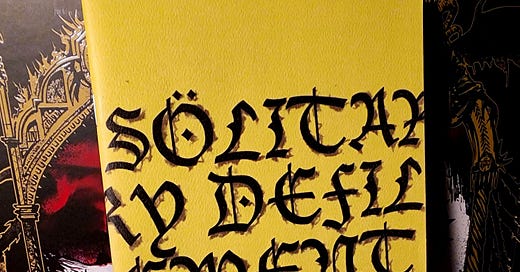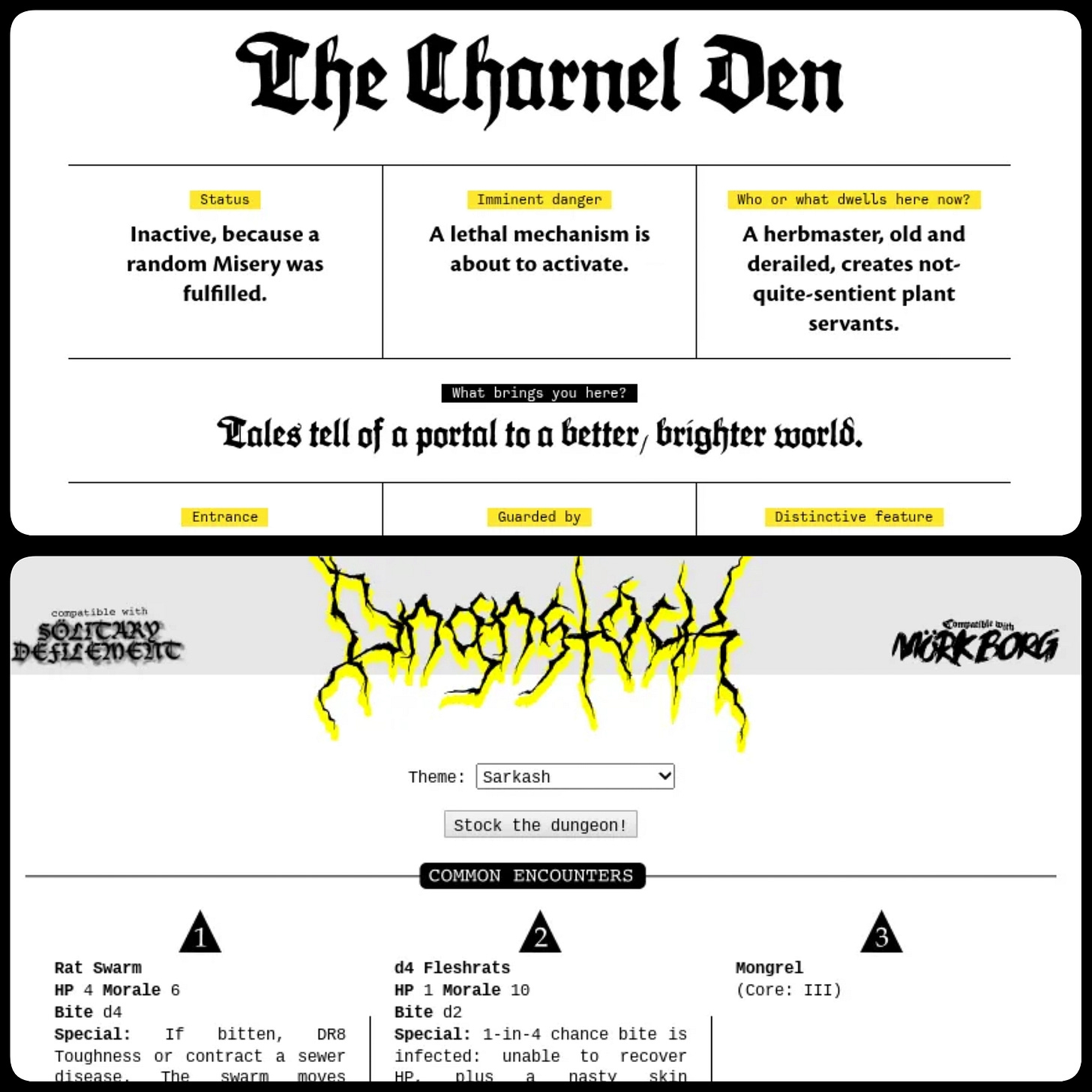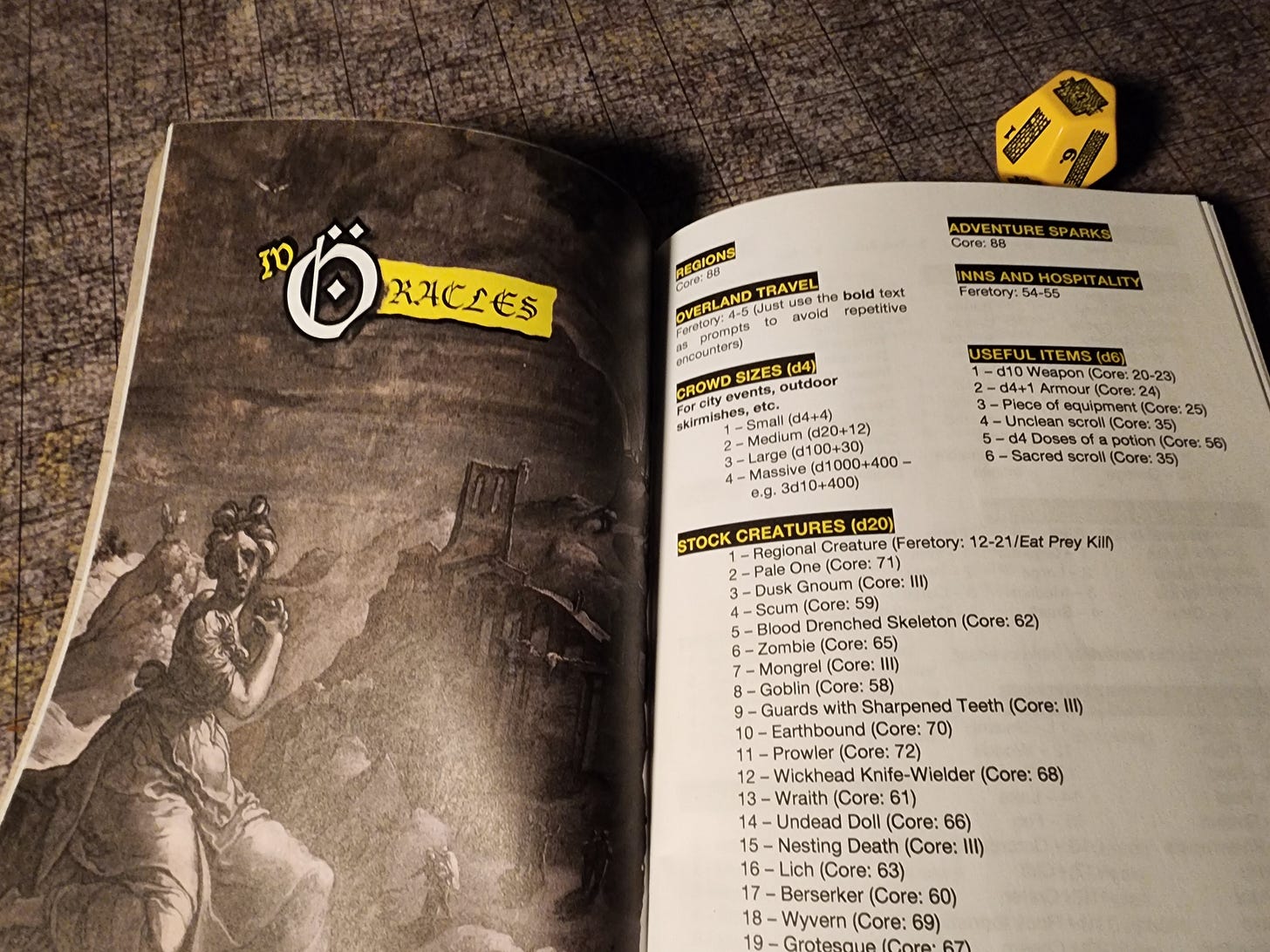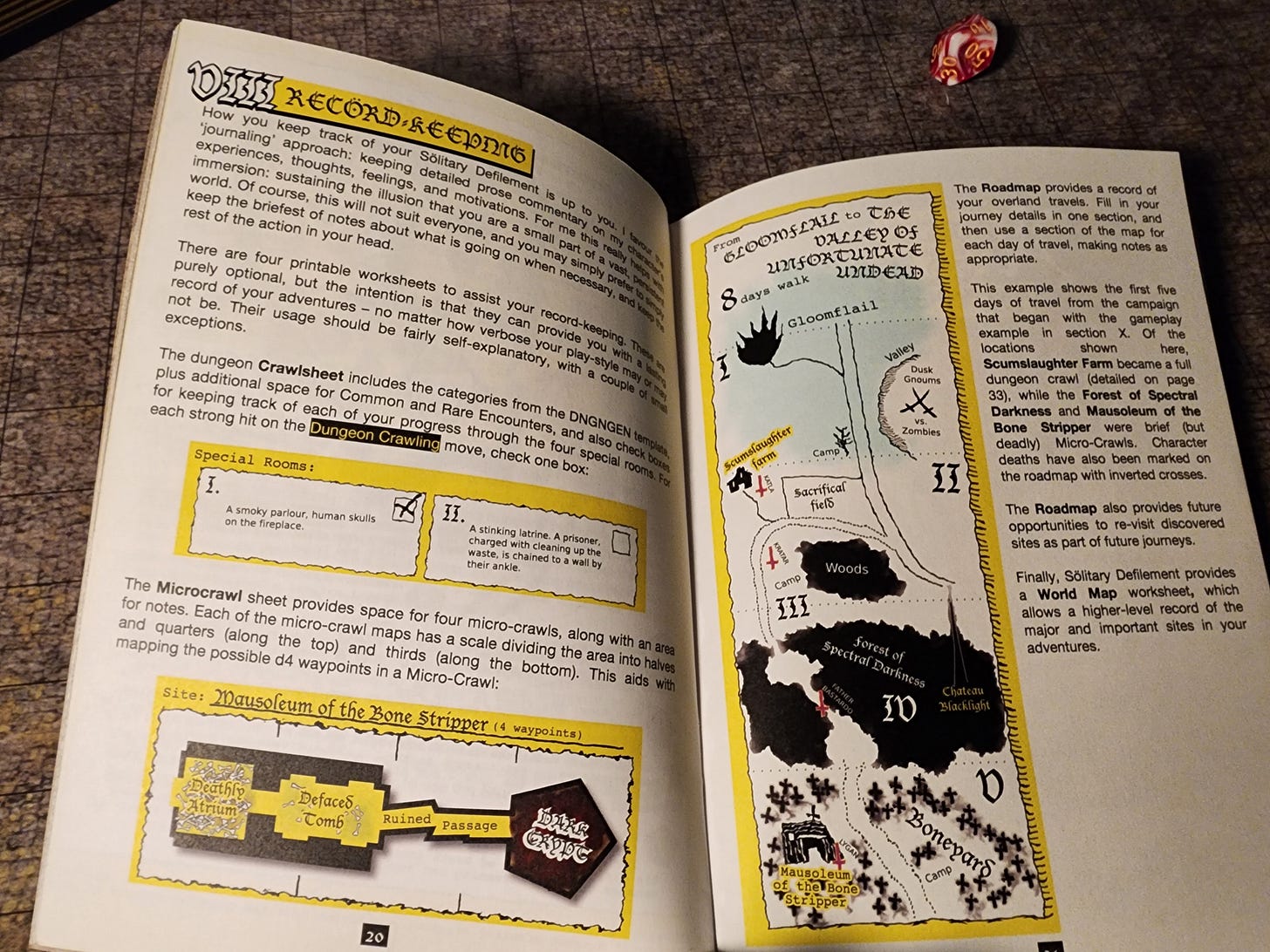For new solo RPG players, creating and playing through a solo dungeon crawl is one thing—but to generate story hooks, unique NPCs, locations, and all the finer details can seem overwhelming. You may even ask yourself, “How can I create a story or a plot if I don’t even know what is going to happen once I leave town?” I loved building dungeons, but I often struggled with what to do in towns, or figuring out a reason to adventure besides “I am here to kill things and get treasure.” Even traveling between points of interest seemed like a scary “what if” that made dungeons feel like a narrative safe space—at least it was the devil I knew.
In a world where solo play can often feel overwhelming, Solitary Defilement emerges as a game-changing supplement that infuses solo Mörk Borg adventures with dynamic narrative twists and emergent storytelling. Drawing heavily on the established rules from the Core Rulebook, Ferretory, and Heretic, Solitary Defilement preserves the familiar mechanics for combat, overland travel, foraging, and resting while introducing fresh innovations. At its core, this supplement brings the Strong Hit/Weak Hit system and a comprehensive set of oracles to the table—tools that answer questions a GM would typically handle with a dice roll. Whether you’re building the Dying Lands dungeon by dungeon or fleshing out every encounter, NPC, and piece of loot, Solitary Defilement is designed to help you start a Mörk Borg solo campaign with confidence.
Strong Hit/Weak Hit System
Roll 2d20 whenever you need to make an ability check or an attack/defence test. This system also applies to resting, foraging, and searching for objects.
Strong Hit: Both dice succeed. You accomplish your goal without complications. (For example, with no modifiers at DR12, this is about a 16% chance.)
Weak Hit: One die succeeds and one fails. You succeed, but it comes at a price—this might mean taking on a penalty, dropping an item, sustaining minor damage, or attracting reinforcements. (At DR12, roughly a 48% chance.)
Miss: Both dice fail. You miss/get hit/fail a check.
With a 64% chance of success and nearly a two-thirds chance of avoiding a wasted turn, this system turns most checks into a narrative opportunity. Special tables are provided for resolving Strong and Weak Hits in varied scenarios such as fleeing combat, searching for an object, camping/resting, and even determining how your adventure concludes. You can also add your Omens (Luck) to some rolls, further influencing the outcome and giving you a reason to hold onto them.
I love the concept of Strong vs. Weak Hits. There’s nothing more frustrating than wasting turns where neither your character nor your enemies land a hit—especially in a game where armor mitigates damage and standard tests are at DR12. For a minimalist RPG, that is way more filler and wasted rounds than I would like. While I do appreciate some humor in my games, it gets old fast seeing two heavily armored combatants look away and flail their arms at each other as the blows barely dent the armor. At that point, I would be willing to see my character knock his enemy (and himself, for that matter) into a vat of acid if it meant I got a hit in and SOMETHING happened.
I prefer that my characters don’t simply die, but more importantly, I prefer to embrace success that comes at a price. Even if my character pays that price, the story advances, and those small complications add excitement to combat, sneaking, climbing, and diplomacy. Imagine your massive zweihander cleaving an enemy, only for it to get stuck in a wooden column—just as reinforcements arrive. Or consider vaulting across a chasm only to have a Sacred Scroll slip from your backpack. Perhaps you manage to deceive the town guard, only for him to later remember your face when he sees your wanted poster.
This system minimizes wasted turns and dead ends while providing ample opportunities for narrative twists. In a game defined by an impending apocalypse—where every moment counts—this mechanic raises both the stakes and the tension, and it might even inspire you to bring this approach to group play. I used to think rolling advantage on d20s was the best use of two dice, but I would gladly choose the Strong Hit/Weak Hit system any day.
Using Solitary Defilement to Create Adventures and Microcrawls
Creating a Dungeon
Utilize tools like DNGNGEN or the Dungeon Generator in the Core Rulebook to create dungeons and special rooms. Once you have the basics, you can flesh out your dungeon with DNGNGENSTOCK for common encounters, rare encounters, and NPCs. You can choose themes based on location or the general vibe of the dungeon.
Difficulty Levels:
DR6: Small dungeons (4–9 rooms on average)
DR12: Medium to large dungeons (9–14 rooms on average)
DR14: Huge dungeons (17–32 rooms on average)
Roll 2d20 + your Luck score:
Strong Hit: You enter a special room.
Weak Hit: You enter a generic room—then roll on the room descriptor oracle and for room contents. These might include unique creatures, common or rare encounters, NPC gatherings, unexpected events, loot, hazards, or even brief respites.
Fail: You trigger a trap, enemy encounter, or calamity—roll for a room description.
Microcrawls
When overland travel leads you to a point of interest—say, encountering a monastery after leaving the main road—a full dungeon crawl would be overkill. Instead, use a microcrawl:
Roll a d4 to determine the number of waypoints.
Then, roll for geographic terrains or area descriptions.
Oracles
Solitary Defilement isn’t just about combat and dungeon delving—it offers oracles designed to help players navigate The Dying Lands without a GM. These oracles address:
Crowd Sizes
Loot
Encounter Creatures
Religious Denominations of Cults
Buildings and Structures
Building Materials
Geographic Features
Sensory Information (sounds, odors/tastes)
NPC Professions and Dispositions
Yes/No Questions (d4):
Yes
Yes, but…
No, but…
No
These oracles answer any questions you might ask a traditional GM, allowing you to generate The Dying Lands one day, one dungeon, and one encounter at a time. Unlike other solo Mörk Borg options that focus solely on dungeon crawling and/or combat (like Dark Fort, Grotten: 1-Bit Deeper, and Forbidden Psalm), Solitary Defilement is designed with the entirety of the Mörk Borg experience in mind—including overland exploration, roleplaying, and worldbuilding. As someone who overthinks, knowing I can roll a d4 to answer Yes/No questions or consult a table to get a feel for my environment is a lifesaver, and it keeps the game moving. Ultimately, the value you get from these oracles is determined by how many questions you ask and your ability to connect the dots. And best of all, as a solo player, you can step away from the game if you need time to figure out how everything fits together.
Solo Play Tools
Solitary Defilement comes equipped with an arsenal of tools for solo Mörk Borg players beyond oracles, tables, and generators. Its clear, digestible instructions, alongside worksheets for recording dungeon crawls (including details for special rooms, microcrawls, and daily travel progress), make it accessible even for those new to solo RPG play. A downloadable world map is also provided—ideal for tracking events across The Dying Lands, especially if you choose to run multiple characters in different regions.
Gameplay examples within the supplement demonstrate how to set up adventures, dungeons, and microcrawls while showcasing core mechanics and overland travel. In true Mörk Borg fashion, Katla, our character died at the end of the examples. Despite Katla’s death, we learn that a cultist that Katla met earlier will be our new Scum. New characters arise from the ashes of the old, and you’re bound to meet an intriguing NPC with main character energy. Life finds a way—even in the Dying Lands.
Final Thoughts
Solitary Defilement transforms solo Mörk Borg play into an experience that’s as unpredictable as it is engaging. By introducing the Strong Hit/Weak Hit system, dungeon crawler tables that work seamlessly with existing Mörk Borg generators, and a suite of oracles for both broad and narrow applications, it ensures that every check and every encounter propels your narrative forward—even when success comes with a twist. No longer are you stuck in repetitive, wasted turns; instead, you’re immersed in a dynamic world where even setbacks enrich the story. Whether you’re delving into dungeons, embarking on microcrawls through perilous lands, or simply exploring overland routes, this supplement offers a robust framework for building the Dying Lands one dramatic moment at a time.
Solitary Defilement is an excellent starting point for solo RPG players looking to graduate from pure dungeon crawls to adventures that offer rich worldbuilding and narrative focus. This book not only shows you how to run Solitary Defilement, but also gives you the examples and tools to see what good looks like, empowering you to let your story unfold with all its unpredictable twists and turns. Equal parts theory and application!
If you are looking to leave the dungeons and venture into the Dying Lands, look no further than Solitary Defilement. What are your experiences and thoughts on Solitary Defilement? Share your insights in the comments below!
Links






